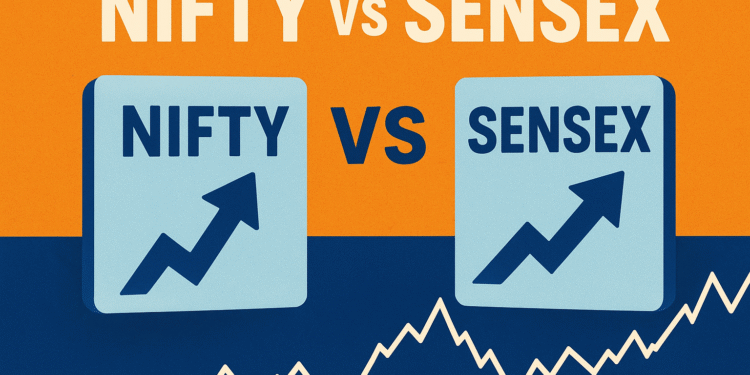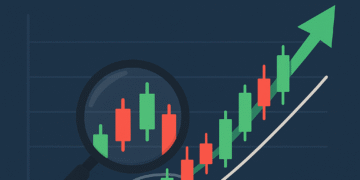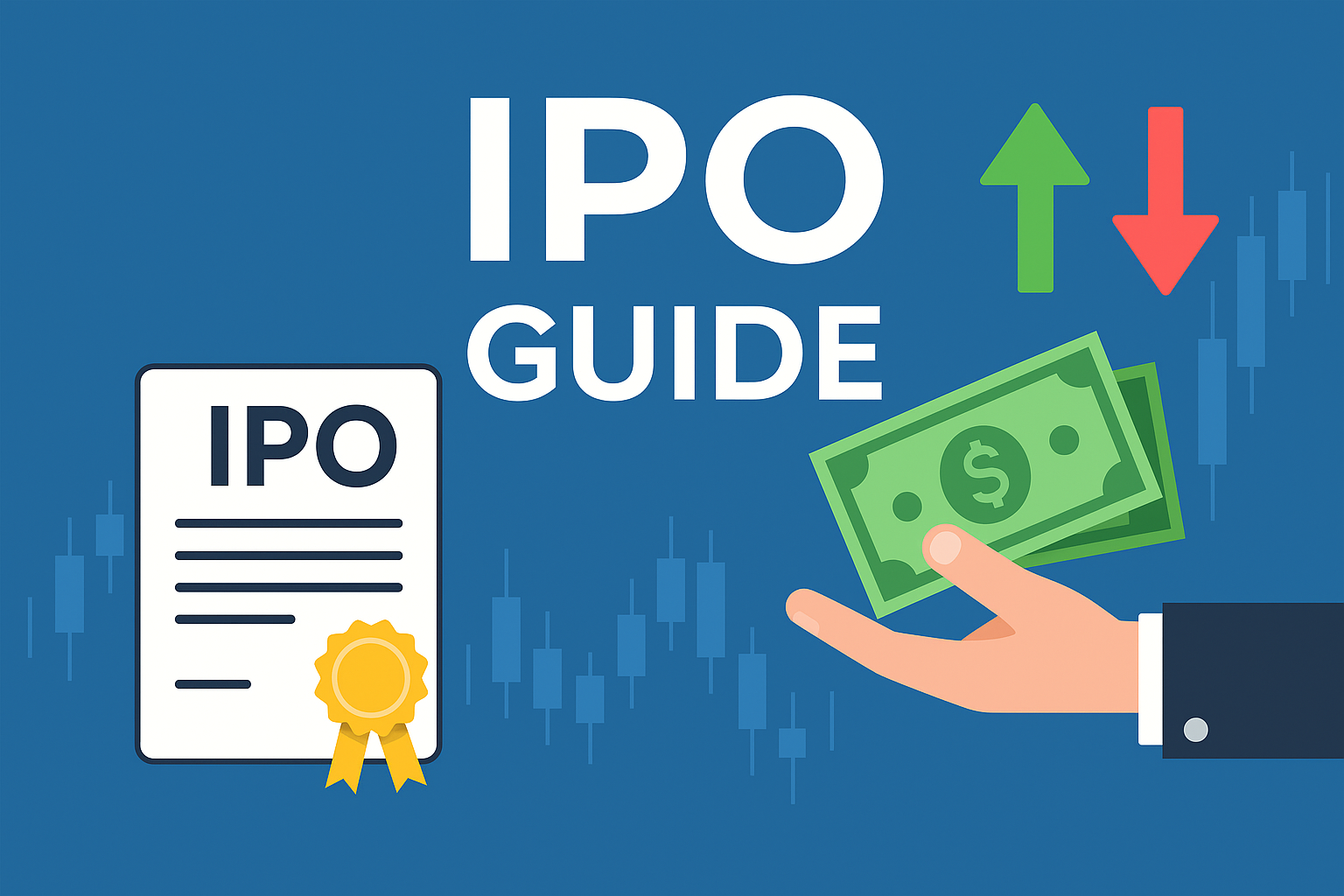Understanding the two main benchmarks helps you read the overall market quickly. These barometers track large-cap companies and guide mutual funds, ETFs, and portfolio managers.
One index is older and iconic, tracing 30 long-established firms from an earlier base year. The other offers broader coverage with fifty top names across many sectors and a more recent base period.
Both use free-float market-cap weighting and reflect market sentiment. They often move in the same direction, so beginners can follow either for a simple view of the market.
Active traders may prefer the broader gauge for derivative liquidity, while long-term investors use either as a reliable benchmark to shape allocation and performance decisions.
Key Takeaways
- These two benchmarks serve as primary gauges of market health for investors.
- One tracks 30 large firms and is the older, established benchmark.
- The other covers 50 companies across many sectors for wider exposure.
- Both use free-float weighting and act as standards for funds and ETFs.
- They typically move together, so beginners can track either index.
- Derivatives traders often favor the broader index for deeper liquidity.
Why Stock Indices Matter in India’s Market Today
Headline benchmarks condense thousands of trades into a single signal that investors watch for clues about economic health. That quick reading helps media, policymakers, and retail traders react without scanning dozens of company charts.
Barometers of sentiment: how indices signal the economy
Daily rises or drops in a major index shape sentiment across the market. A sharp fall can trigger caution, while steady gains boost confidence.
Because these measures track large, liquid companies, they act like a thermometer for broader economic mood.
Benchmarks for funds, ETFs, and portfolios
Fund managers and ETF issuers use a trusted benchmark to gauge performance. Passive funds mirror the index to match market returns.
Flows into ETFs often follow index moves and can change prices through rebalancing. That link makes the index a practical tool for portfolio planning.
| Function | What it shows | Who uses it | Impact |
|---|---|---|---|
| Sentiment gauge | Market-wide direction | Media, investors, policymakers | Sets daily tone |
| Performance benchmark | Fund and ETF tracking | Asset managers, advisors | Guides allocation |
| Liquidity signal | Investor flows and trading depth | Global investors | Attracts capital |
NSE vs BSE: Exchanges Behind Nifty and Sensex
Two primary stock exchange venues support India’s benchmark measures and shape how capital flows through the market.

National Stock Exchange vs Bombay Stock Exchange at a glance
The national stock exchange launched its flagship benchmark in 1996 with an electronic, screen-based model that sped modern trading adoption.
The bombay stock exchange predates it, with its benchmark introduced in 1986 and a long legacy among listed companies.
- Home index size: 50 constituents on the newer benchmark, 30 on the older one.
- Historical role: BSE is older; the other built modern electronic infrastructure.
- Products: Both exchanges host ETFs and index funds for investor access to large-cap exposure.
Liquidity, participation, and trading infrastructure
Derivatives activity grew faster on the newer exchange, so futures and options there are often the most traded contracts. That trend concentrates liquidity and tightens spreads for active traders.
Order matching, risk systems, and clearing frameworks on both venues support price discovery and execution quality. Long-term investors can use either index to capture broad market exposure.
S&P BSE Sensex: India’s Oldest Index Explained
Tracing back to a 1978–79 base year, this long-running gauge tracks marquee firms that shape the market.
Origins and base year
Introduced in 1986, this S&P BSE benchmark uses a base value of 100 tied to 1978–79. It evolved into the oldest widely cited measure of India’s large-cap segment.
Constituents and coverage
The index includes 30 established companies chosen for market capitalisation, liquidity, trading activity, and sector spread. That blue-chip tilt means household names from financials, energy, IT, and consumer staples dominate the list.
Weighting follows a free-float approach, so only publicly available shares determine each component’s influence rather than total outstanding equity.
| Feature | Details | Investor use |
|---|---|---|
| Constituents | 30 large companies | Large-cap exposure |
| Base | 1978–79; base value 100 | Historical comparison of value |
| Method | Free-float market capitalisation | Represents tradable shares |
| Role | Blue-chip performance gauge | Benchmark for funds and ETFs |
NSE Nifty 50: The Broad Market Benchmark
Built on a 1995 base period and a base value of 1000, this fifty-company benchmark launched in 1996 to give a wider snapshot of large-cap market activity. It tracks the largest and most liquid names across roughly 24 sectors.
The national stock exchange flagship reflects about 65% of the exchange’s free-float market capitalisation. That reach makes it a comprehensive barometer for overall market health and performance.
Selection favors companies listed with high liquidity, strong market capitalisation, and balanced sector representation. The index uses a free-float methodology with an investable weight factor so only tradable shares shape component weights.
Global and local investors favor this gauge for its breadth and tradability. A wide range of funds, ETFs, and derivatives track the benchmark, helping portfolio managers and traders access diversified large-cap exposure.

| Feature | Key detail | Investor benefit |
|---|---|---|
| Launch / base | 1996; base period 1995; base value 1000 | Historical value context |
| Coverage | 50 companies across ~24 sectors | Broader market snapshot |
| Method | Free-float with IWF | Reflects tradable market capitalisation |
nifty vs sensex difference NSE vs BSE stock indices India Sensex vs Nifty return
Look to constituent count and exchange home to see the clearest contrasts between these two headline measures.
Key structural contrasts include company count (50 versus 30), the exchange each belongs to, and their base settings. One benchmark uses a 1995 base period with a base value of 1000, while the other traces back to 1978–79 with a base of 100.
Both follow free-float weighting, so tradable shares decide each component’s influence. That keeps the index aligned with real market supply and demand.
- Coverage: 50 companies gives broader sector reach; 30 offers a compact blue-chip view.
- Exchanges: Each benchmark is central to its home exchange and product ecosystem.
- Trading: The broader gauge tends to attract heavier derivatives volume and liquidity.
- Performance: Long-run outcomes are usually similar, with small divergences from sector mix and rebalancing.
For most investors, choice depends on use case: trading efficiency and liquidity, or a simpler blue-chip basket for benchmark tracking.
Methodology and Calculation: Free-Float Market Capitalization
Index levels are driven by the market value of tradable shares, not total share counts.

How free-float market cap determines weights
Free-float means only publicly tradable holdings count toward a company’s weight. Promoter stakes, government blocks, and other restricted holdings are excluded.
This approach gives a clearer view of investable supply and aligns the index with real market flows.
Step-by-step calculation
The process is straightforward:
- Compute each firm’s market capitalisation (share price × total shares).
- Apply the free-float factor or Investable Weight Factor to get free-float market cap.
- Sum free-float market capitalisation across constituents to find the aggregate.
- Divide current aggregate by the base market cap and multiply by the base value to get the index level.
Base values and what they imply
One benchmark uses a base value of 100 tied to 1978–79. The other uses a base value of 1000 with 1995 as its reference period.
Scaling to different base values does not alter economic meaning; it only sets a historical reference for comparison.
Rebalancing and eligibility
Regular reviews keep each index current. Eligibility requires liquidity, sufficient market capitalisation, and steady trading frequency.
Corporate actions such as splits, mergers, and buybacks update free-float factors so the index reflects real changes in investable shares.
“Transparent, rule-based weighting using free-float market capitalisation builds confidence and comparability over time.”
| Item | Sensex-style | Nifty-style |
|---|---|---|
| Base value | 100 (1978–79) | 1000 (1995) |
| Free-float treatment | Free-float market capitalisation | Free-float market capitalisation with IWF |
| Key eligibility | Liquidity, size, trading frequency | Liquidity, size, trading frequency, sector balance |
| Update cadence | Periodic reviews and corporate-action adjustments | Periodic reviews and corporate-action adjustments |
Bottom line: Both benchmarks are calculated using free-float methods that focus on investable capitalisation. That shared methodology helps explain why they move similarly over time despite different breadth and base values.
Breadth and Sector Exposure: Broader vs Compact Coverage
Coverage and sector mix shape how each headline measure reacts to economic shifts.
Nifty’s wider sectoral representation
The 50 companies composition brings broader coverage across about 24 sectors and captures roughly 65% of the exchange’s free-float market cap. This wider footprint means more industries are represented, which can dilute the impact of a single sector shock.
Sensex’s concentrated, blue-chip tilt
Sensex’s 30-stock approach concentrates weight in a few leading fields, often financials and energy. That concentration can amplify moves when those sectors rally or slump.
How sector weights drive short-term performance:
- Overweight sectors exert outsized influence on index moves.
- Broader coverage can slightly lower volatility from sector-specific shocks.
- Concentration can boost gains when dominant sectors outperform.
Both measures focus on large-cap names and often share mega-cap leaders, which keeps their market behaviour correlated. Investors should check sector exposure before choosing a benchmark for a portfolio, since rebalances shift representation as the economy and market leadership evolve.
Performance and Historical Returns: Sensex vs Nifty Over Time
Across long horizons both headline benchmarks show strong growth and broadly similar performance. Investors who hold for a decade or more typically see compounded gains tied to economic expansion, corporate earnings, and liquidity.

Long-term trend: similar gains with minor divergence
Over multi-decade spans, the two measures often deliver comparable compounded outcomes because they both track large-cap companies that drive the market. Small gaps appear when sector cycles favor one set of constituents over the other.
Drawdowns and recoveries are usually correlated due to shared mega-cap names and common macro drivers. That makes both a reliable gauge for strategic asset allocation for long-term investors.
Illustrative 10–20 year CAGR comparison
To see the concept, compare rolling 10- and 20-year compound annual growth rates (CAGR). Over many windows the CAGR of each benchmark converges, showing similar value creation for diversified large-cap exposure.
| Window | Illustrative CAGR — Benchmark A | Illustrative CAGR — Benchmark B | Key driver |
|---|---|---|---|
| 10 years | 10–14% (approx.) | 9–13% (approx.) | Sector leadership and liquidity |
| 20 years | 11–13% (approx.) | 11–13% (approx.) | GDP growth and corporate earnings |
| Notes | Past performance is illustrative, not a guarantee. Differences stem from breadth, sector weights, and timing of constituent changes. |
Bottom line: For most long-term investment goals, either benchmark offers a dependable way to capture large-cap market performance. Focus on horizon, costs, and implementation rather than small historical spreads.
Trading, Derivatives, and Liquidity: What Active Investors Prefer
When speed, cost and execution count, traders choose the venue with the deepest contract books. That choice shapes where speculative flows, hedges, and market makers concentrate their activity.
Why one benchmark sees heavier futures and options activity
Futures and options volumes cluster where daily participation is highest. Heavy flows attract more market makers and arbitrageurs, which tightens spreads and improves price discovery.
- Dominant contracts draw both retail and institutional engagement, boosting open interest and depth.
- Higher liquidity reduces slippage and lowers transaction costs for active strategies.
- A broad range of expiries and strikes lets traders craft precise hedges and tactical positions.
Practical edge for active traders: consistent quotes and continuous order flow help intraday and swing approaches execute reliably. While alternate benchmarks have derivative offerings, most short-term hedges and speculative trades follow the most traded contract because it delivers better execution and lower implicit costs.
| Feature | Heavily Traded Contract | Alternate Contract |
|---|---|---|
| Daily volume | Very high | Moderate |
| Bid-ask spreads | Tight | Wider |
| Strike/expiry choices | Broad | Limited |
| Best for | Active hedging, arbitrage, intraday trading | Benchmarking, long-term exposure |
Which Index to Use: By Goal and Experience Level
Your investment horizon and trading experience should guide which benchmark you follow. Each measure tracks large-cap companies and acts as a clear barometer of the market. Use purpose, cost, and product access to make practical decisions.
Beginners
Either index works well for new investors. Both deliver broad exposure to leading stocks and move closely over time. Focus on low-cost funds, ease of access, and consistency in tracking performance rather than switching frequently.
Active traders
Choose the index with deeper derivatives and tighter spreads. Higher liquidity helps intraday and options strategies. Execution quality and available contracts matter more than minor composition differences for short-term trading.
Long-term investors
Both indices serve as reliable benchmarks for strategic equity allocation. Risk profiles are similar, though a broader coverage can slightly smooth sector swings. Decide based on your existing portfolio, product availability, and expense ratios.

“Pick one benchmark and stick with it for measurement; changing references adds noise to long-term planning.”
- Compare tracking error, expense ratios, and liquidity before selecting a fund.
- If desired, hold both via low-cost funds — benefits may be marginal but possible.
Conclusion
These two flagship measures give a quick, reliable snapshot of major-company performance and market direction. Both act as premier benchmarks that funds, ETFs, and advisors use to gauge broad economic health.
The nifty index (the fifty-company gauge launched in 1996 on the national stock exchange) offers broader sector coverage and deeper derivatives liquidity. The compact thirty-member gauge on the bombay stock exchange traces long-standing blue‑chip names and a longer base history.
Both use free-float methodology and similar calculation rules, so long-term performance trends are often close, with small gaps from sector mix and constituent shifts.
Practical takeaway: beginners can follow either index; active traders may favour the more traded benchmark; long-term investors should prioritise low cost, tracking quality, and liquidity. Focus on fit, not superiority, to align choices with your goals and risk profile.
FAQ
What are the primary differences between the two main Indian indices?
The main distinctions lie in number of constituents and sector spread. One index tracks 50 large-cap companies across more sectors, offering broader market coverage. The other follows 30 large, established companies with a concentrated blue-chip focus. Both use free-float market capitalization to weight components, but their compositions and sector tilts drive small performance and volatility differences.
Why do stock indices matter for investors in India?
They act as market barometers, signaling economic sentiment and capital flow. Fund managers, ETFs, and portfolio benchmarks use these indices to measure performance. Retail and institutional investors rely on them for asset allocation, passive investing, and tracking market trends.
How do the two exchanges behind these indices differ?
The National exchange offers higher trading volumes and is popular for derivatives. The Bombay exchange is older, with deep historical presence and strong institutional listings. Differences show up in liquidity, market participation, and trading infrastructure rather than in methodology.
What is the history of India’s oldest benchmark?
The oldest benchmark has roots in the late 1970s and was formally launched in the mid-1980s. It was created to represent blue-chip companies and has since served as a primary benchmark for long-term investors and policy watchers.
When was the broader 50-stock benchmark introduced?
The broader benchmark was introduced in the mid-1990s with a base period set shortly before launch. It was designed to capture wider sector representation and serve as the go-to index for derivatives and broad-market funds.
How does free-float market capitalization affect index weights?
Free-float market cap weights companies based on publicly available shares, excluding promoter and locked-in holdings. This approach gives a realistic measure of investable size and determines each company’s influence on index moves.
Do the two benchmarks use the same base values and calculation approach?
Both use similar free-float market-cap methods, but their base values and reference dates differ. Those base settings are historical anchors and do not affect the comparative economic signals the indices provide.
How often are index constituents reviewed and changed?
Index committees perform periodic reviews and rebalancing based on eligibility criteria like market cap, liquidity, and corporate actions. Changes keep indices current and investable for funds and ETFs.
Which benchmark offers broader sector coverage?
The 50-stock benchmark covers more sectors and provides wider exposure to the Indian economy. The 30-stock benchmark leans toward a concentrated set of large-cap industries, emphasizing stability and blue-chip names.
How do long-term returns compare between the two?
Over long horizons, both benchmarks show broadly similar returns with occasional divergence driven by sector performance and constituent changes. Differences are usually modest over 10–20 year periods.
Which index is preferred for derivatives and active trading?
The broader 50-stock benchmark sees heavier trading in futures and options due to higher liquidity and deeper derivatives markets. This makes it attractive to active traders and hedge funds.
Which benchmark should I use for building a beginner’s portfolio?
For beginners, either index works as a market-cap representation of India’s large-cap universe. Choice depends on whether you prefer broader sector exposure or concentrated blue-chip holdings; many passive funds track both options.
Are both indices reliable for long-term investors?
Yes. Both provide robust, time-tested benchmarks for long-term allocation. Diversified investors often use funds tracking each index or combine them to balance exposure and risk.
How do liquidity and market capitalization affect investor decisions?
Higher liquidity makes it easier to enter and exit positions and supports tight bid-ask spreads for derivatives. Market-cap weighting ensures larger, more investable companies have greater influence, shaping portfolio construction and passive fund flows.










